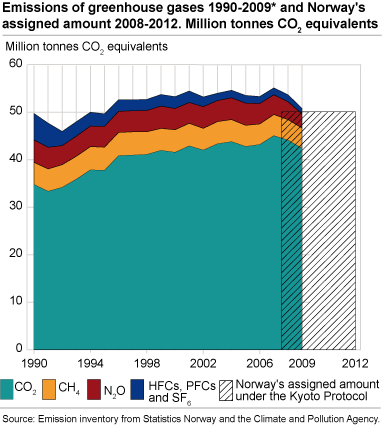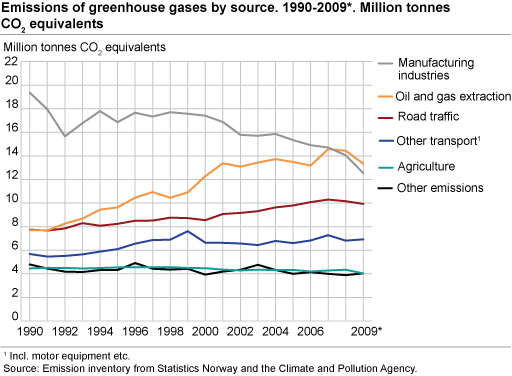Content
Published:
This is an archived release.
Large reduction in greenhouse gas emissions
Norwegian greenhouse gas emissions in 2009 amounted to 50.8 million tonnes CO2 equivalents. This is 5.4 per cent lower than in 2008. The strong reduction is partly due to lower emissions from manufacturing industries and oil and gas activities. There is reason to believe that the emissions continue to be influenced by the financial crisis.
This is indicated in preliminary figures in the Norwegian emission inventory, which is compiled by Statistics Norway in collaboration with the Climate and Pollution Agency.
For the second year running, Norway’s total greenhouse gas emissions have decreased. In 2009, 50.8 million tonnes CO2 equivalents were emitted, which is the lowest level since 1995. A great deal of the reduction is due to lower emissions from the manufacturing industries and oil and gas activities, but emissions from road traffic and agriculture also decreased.
Continued emission decrease in manufacturing industries
The emissions from manufacturing industries were reduced from 14 million tonnes CO2 equivalents in 2008 to 12.5 million tonnes in 2009, which represents a 10.7 per cent reduction. There is a particularly strong reduction from metal production - according to Statistics Norway’s monthly index of production, http://www.ssb.no/english/subjects/08/04/pii_en the production was reduced by 20 per cent in the same period. This must be regarded as a result of the international financial crisis. Over time, the industry will recover from the crisis, which in turn may lead to higher emissions. Emissions of N2O from chemical manufacturing, which include production of fertiliser, also decreased.
Power supply is included in manufacturing industries in the emission statistics. Due to higher activity at the gas power plant at Kårstø, combustion emissions from manufacturing industries have increased somewhat.
| 2009 |
Per cent change
2008-2009 |
Per cent change
1990-2009 |
|||||||||||||||||||||||||||||||||||||||||||||||||||||||||||||||||||||||||||||
|---|---|---|---|---|---|---|---|---|---|---|---|---|---|---|---|---|---|---|---|---|---|---|---|---|---|---|---|---|---|---|---|---|---|---|---|---|---|---|---|---|---|---|---|---|---|---|---|---|---|---|---|---|---|---|---|---|---|---|---|---|---|---|---|---|---|---|---|---|---|---|---|---|---|---|---|---|---|---|---|
| Total | 50.8 | -5.4 | 2.2 | ||||||||||||||||||||||||||||||||||||||||||||||||||||||||||||||||||||||||||||
| Manufacturing industries1 | 12.5 | -10.7 | -35.2 | ||||||||||||||||||||||||||||||||||||||||||||||||||||||||||||||||||||||||||||
| Oil and gas extraction | 13.3 | -7.6 | 73.1 | ||||||||||||||||||||||||||||||||||||||||||||||||||||||||||||||||||||||||||||
| Road traffic | 9.9 | -2.2 | 28.2 | ||||||||||||||||||||||||||||||||||||||||||||||||||||||||||||||||||||||||||||
| Other transport2 | 6.9 | 1.6 | 21.9 | ||||||||||||||||||||||||||||||||||||||||||||||||||||||||||||||||||||||||||||
| Agriculture | 4.0 | -7.1 | -9.4 | ||||||||||||||||||||||||||||||||||||||||||||||||||||||||||||||||||||||||||||
| Other emissions | 4.0 | 3.9 | -15.8 | ||||||||||||||||||||||||||||||||||||||||||||||||||||||||||||||||||||||||||||
| 1 | Including electricity supply. |
| 2 | Incl. motor equipment etc. |
|
Source:
Emission inventory from Statistics Norway and the Climate and
Pollution Agency. |
|
Lower emissions from oil and gas activities
Greenhouse gas emissions from oil and gas activities were also reduced considerably from 2008 to 2009. In all, emissions from oil and gas activities were reduced by 7.6 per cent, or 1.1 million tonnes CO2 equivalents. The main cause was lower emissions from flaring, particularly at the LNG plant at Melkøya. In addition, the total production of petroleum products was reduced by approximately 2.5 per cent.
Reduced emissions from road traffic
Emissions of greenhouse gases from road traffic increased considerably during the period 1990-2007, while declining somewhat in 2008. This development continued in 2009, with a 2.2 per cent emission decrease compared with 2008. Statistics Norway’s preliminary energy balance http://www.ssb.no/english/subjects/01/03/10/energiregn_en/ shows that the use of petrol in road transport in particular declined. As the decrease in use of petrol was larger than the increase in the use of auto diesel, the total fuel use for road transport was lower in 2009 than in 2008. In addition, a higher bio diesel share in auto diesel contributed to a further emission decrease. The emissions in 2009 were still approximately 28 per cent higher than in 1990. Emissions from other transport increased by 0.1 million tonnes CO2 equivalents, but these figures are still quite uncertain.
Less nitrous oxide from agriculture
Greenhouse gas emissions from agriculture were reduced by more than 7 per cent from 2008 to 2009. This is mainly due to lower emissions of N2O from use of nitrogen fertiliser. The decrease might be explained by a strong price increase for nitrogen fertiliser, which caused a stock building in 2008 and corresponding lower purchases in 2009. The calculation of N2O emissions from use of nitrogen fertiliser is based on sales figures for each year. In addition, new fertilisation standards may have brought about reduced amounts of fertiliser.
The Kyoto targets
Norway’s allocated quota amount in the Kyoto Protocol is 250.6 million tonnes CO2 equivalents for the period 2008-2012. This equals annual greenhouse gas emissions averaging 50.1 million tonnes for each of the five years. In 2008, which was the first year for which the Kyoto Protocol applied, the emissions amounted to 53.7 million tonnes, whereas 50.8 million tonnes CO2 equivalents were emitted in 2009. According to the Kyoto Protocol, parts of Norway’s carbon sinks in wood can be deducted from this amount. However, it has been stated that this deduction will not be used to fulfil the Kyoto targets. Norway’s obligation in the Kyoto Protocol will be fulfilled through a combination of emission reductions nationally and the purchase of quotas by companies and the Government. At present, the emission reductions, together with the purchase of quotas by companies, are sufficient to fulfil Norway’s obligations in the Kyoto Protocol. The purchase of quotas by the Government will probably be needed to achieve the national target to exceed the Kyoto target by 10 per cent.
About the emission inventoryThe figures for 2009 presented in this article are preliminary, but still relatively reliable. Detailed tables for 2009, including distributions between source and industry, will not be published until February 2011. After the publication of emission figures for 1990-2008 in February 2010, some of the figures have been changed, which has caused a revision of the whole time series. See documentation of the emission accounts . See also emissions of NMVOC, nitrogen oxides, sulfurdioxide og ammonia and : emission intensity . |
Tables:
- Table 1 Emissions to air, by source. 1990
- Table 2 Emissions to air, by source. 2007
- Table 3 Emissions to air, by source. 2008*
- Table 4 Emissions to air of greenhouse gases. 1973-2009*
- Table 5 Emissions to air of greenhouse gases by industry. 1990, 2007, 2008 and 2009. 1 000 tonnes CO2equivalents. Change in per cent
This page has been discontinued, see Emissions to air, Annually.
Contact
-
Trude Melby Bothner
E-mail: trude.melby.bothner@ssb.no
tel.: (+47) 40 81 14 25
-
Berit Storbråten
E-mail: berit.storbraten@ssb.no
tel.: (+47) 40 81 14 23


